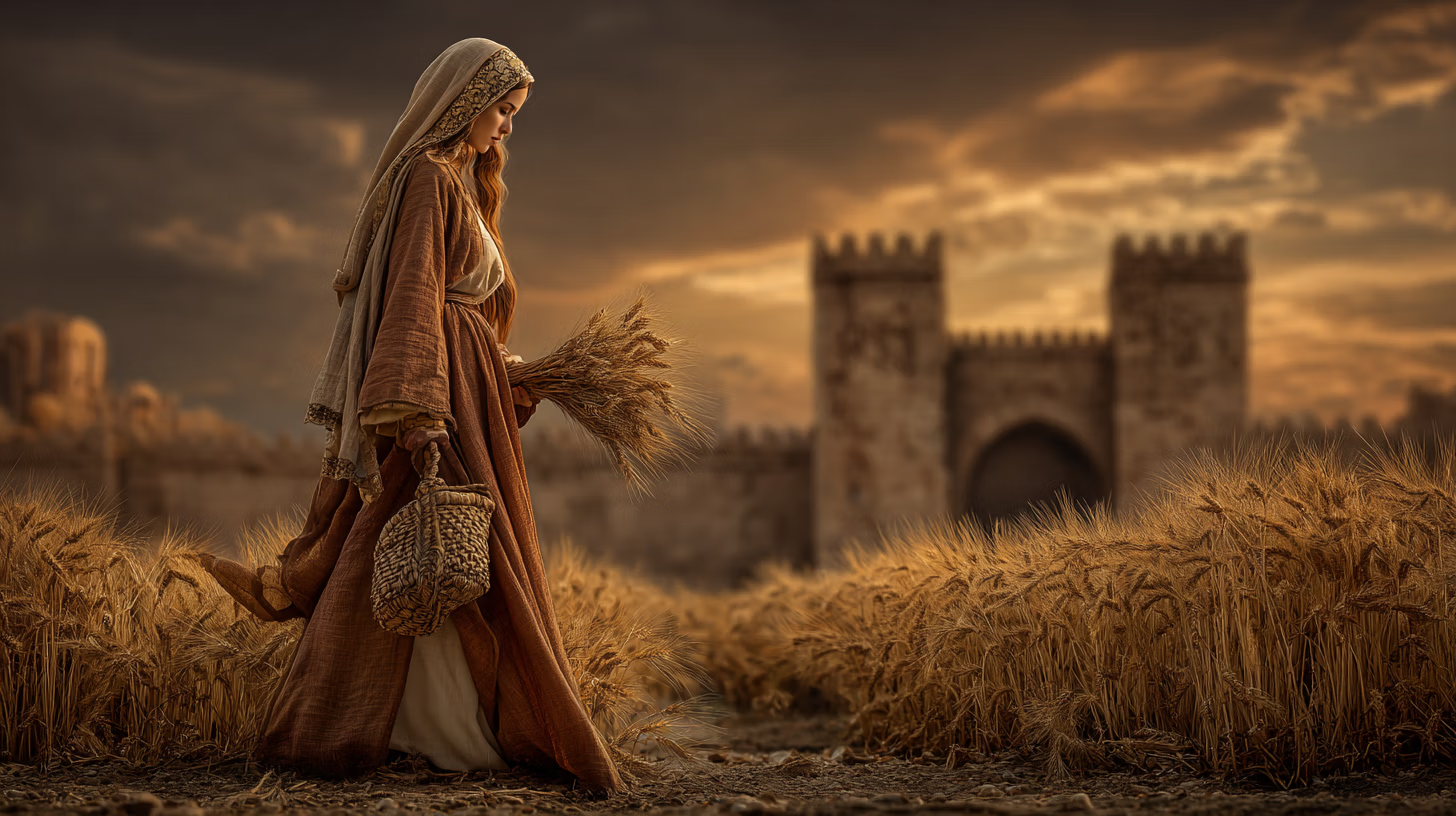
The Book of Ruth Chapter 4 culminates in one of Scripture’s most beautiful redemption stories. This final chapter reveals how God orchestrates circumstances through faithful obedience, transforming a pagan widow’s loyalty into the lineage of King David and ultimately Jesus Christ, demonstrating that divine providence works through ordinary people making extraordinary choices.
Table of Contents
The Gate of Decision: Where Legal Matters Meet Divine Purpose
What happens at the city gate in Ruth Chapter 4 and why is it significant? The city gate in ancient Bethlehem served as the center for legal transactions and public witness. When Boaz positions himself there with ten elders, he establishes a formal legal proceeding that will determine Ruth’s future and fulfill God’s redemptive plan for both women.
In the Book of Ruth Chapter 4, we witness Boaz’s masterful navigation of ancient Hebrew law. The gate wasn’t merely an entrance to the city—it represented the heart of civic life where business transactions, legal proceedings, and important decisions took place. When Scripture tells us:
“Boaz went up to the gate and sat down there” (Ruth 4:1)
This signals his intention to conduct official business with proper witnesses.
The timing proves divinely orchestrated. The unnamed kinsman redeemer “just happens” to pass by—though anyone familiar with God’s providence knows nothing happens by chance. Boaz has clearly prepared for this moment, having ten elders ready to serve as witnesses. This wasn’t random; Jewish law required ten men for certain legal proceedings, establishing what would later become the minyan tradition.
The legal framework here mirrors our own constitutional principles. Just as America’s founders insisted on transparent legal processes with witnesses and documentation, ancient Israel maintained strict protocols for property transfers and marriage arrangements. This parallel reminds us that biblical principles provide timeless truths about justice, transparency, and the rule of law that transcend cultures and centuries, principles we explore further in our Bible Messages series.
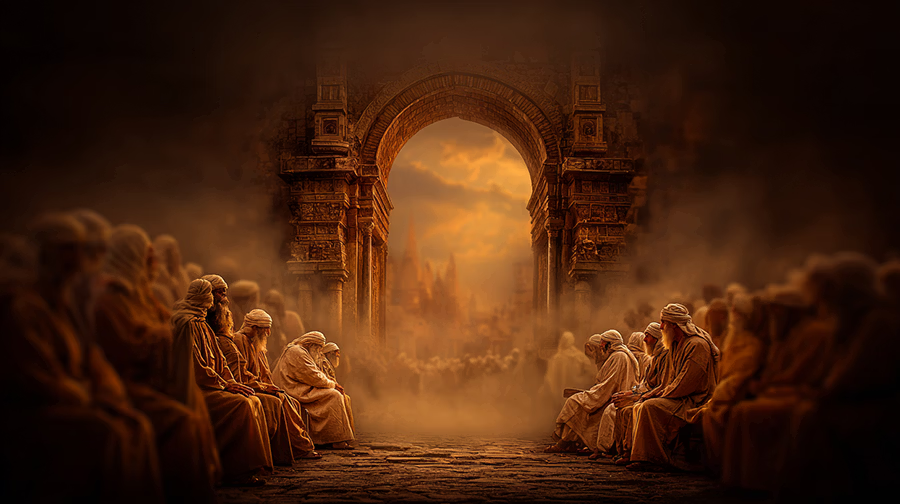
The Unnamed Kinsman: When Fear Overrides Opportunity
The closer relative remains nameless throughout Scripture—a literary device highlighting his ultimate insignificance in God’s redemptive plan. Initially eager to acquire Elimelech’s property, he quickly retreats when learning Ruth comes with the land. His response reveals a man governed by calculation rather than compassion:
“I cannot redeem it for myself, lest I ruin my own inheritance” (Ruth 4:6)
This unnamed kinsman represents those throughout history who miss divine appointments because they’re protecting earthly interests. His fear of “ruining” his inheritance by taking a Moabite widow speaks to prejudices and calculations that blind us to God’s greater purposes. In our contemporary context, we see similar dynamics when believers hesitate to embrace God’s call because it might disrupt their comfortable plans or challenge their social standing.
The Sandal Covenant: Ancient Customs with Eternal Implications
What is the significance of the sandal exchange in Ruth Chapter 4? The removal and exchange of a sandal served as a legal symbol of transferring property rights in ancient Israel. This physical act, witnessed by the elders, created an irrevocable legal transaction, demonstrating how God uses cultural customs to accomplish His divine purposes.
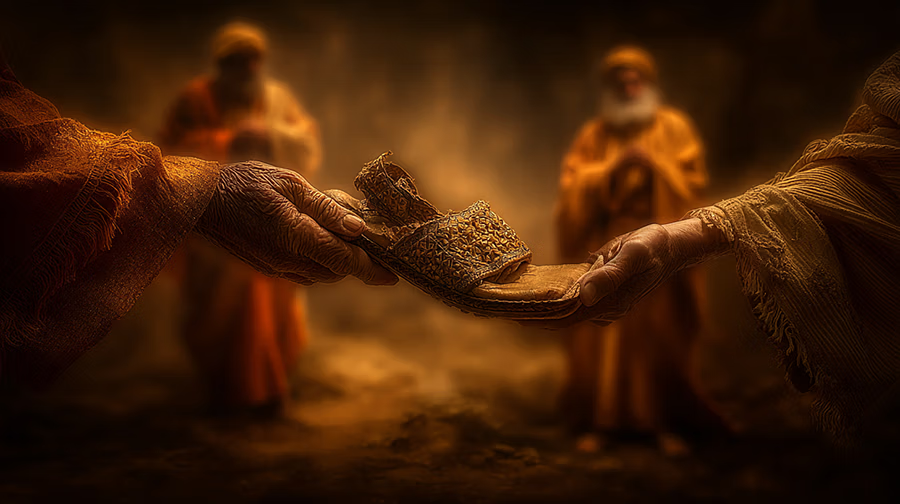
The Book of Ruth Chapter 4 preserves this fascinating glimpse into ancient legal customs:
“Now this was the custom in former times in Israel concerning redeeming and exchanging, to confirm anything: one man took off his sandal and gave it to the other” (Ruth 4:7)
This wasn’t merely symbolic—it carried the weight of a signed contract in our modern understanding.
The sandal represented one’s right to walk upon and possess land. By removing his sandal and handing it to Boaz, the unnamed kinsman publicly relinquished all claims to both the property and Ruth. This tangible act, witnessed by the elders and gathering crowd, created an unbreakable legal precedent. No one could later challenge Boaz’s right to redeem both the land and Ruth.
This physical confirmation of spiritual truths resonates throughout Scripture. From circumcision as a sign of covenant to baptism as an outward expression of inward faith, God consistently uses tangible acts to seal spiritual realities. The sandal ceremony reminds us that faith isn’t merely intellectual—it requires concrete action and public commitment.
Boaz’s Declaration: Righteousness Made Public
With the legal obstacles removed, Boaz makes his declaration before the assembled witnesses:
“You are witnesses this day that I have bought all that was Elimelech’s… Moreover, Ruth the Moabitess, the widow of Mahlon, I have acquired as my wife, to perpetuate the name of the dead through his inheritance” (Ruth 4:9-10)
This public proclamation serves multiple purposes: legal confirmation, social acceptance, and spiritual testimony.
Notice Boaz doesn’t hide Ruth’s Moabite origins or her status as a widow. He openly acknowledges these facts that others might consider liabilities, transforming them into a testimony of God’s inclusive grace. His declaration demonstrates respect for family legacy while embracing God’s forward-looking purpose.
In our current cultural moment, when identity politics and social divisions threaten national unity, Boaz’s example speaks powerfully. He doesn’t erase Ruth’s past or pretend she’s someone she’s not. Instead, he publicly honors her while bringing her fully into the covenant community. This models how our faith should engage with contemporary challenges, neither compromising truth nor excluding those God is calling, principles relevant to the concerns we address in Today’s Concerns.
The Blessing of the Community: Prophetic Words Fulfilled
How does the community’s blessing in Ruth Chapter 4 reveal God’s plan? The elders and witnesses prophetically bless Ruth and Boaz, comparing Ruth to Rachel and Leah who built Israel’s house. Their words unknowingly prophesy the coming of King David and ultimately the Messiah, showing how God uses community affirmation to confirm His purposes.
The response from the witnesses transcends mere social pleasantry. Their blessing carries prophetic weight:
“The Lord make the woman who is coming to your house like Rachel and Leah, the two who built the house of Israel” (Ruth 4:11)
This comparison places Ruth, a Moabite convert, on equal footing with the matriarchs of Israel—a radical statement of acceptance and honor.
The witnesses continue with another significant comparison:
“May your house be like the house of Perez, whom Tamar bore to Judah” (Ruth 4:12)
This reference to Tamar—another woman who secured her place in the messianic line through unconventional means—creates a theological connection between different stories of redemption. God consistently works through situations that challenge human conventions while maintaining divine standards.
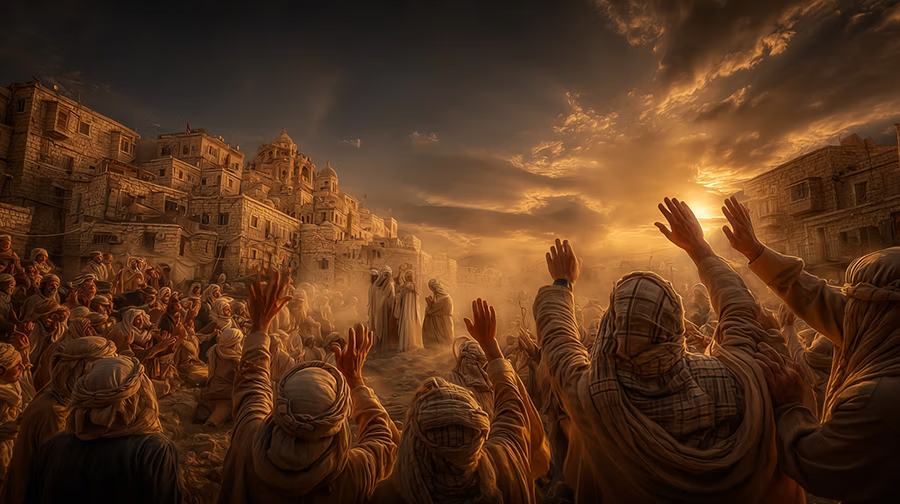
The community’s role here teaches us about the importance of corporate witness and blessing. In our individualistic age, we often forget that God designed faith to be lived in community. The witnesses at the gate didn’t merely observe a legal transaction—they participated in God’s redemptive story, their words becoming part of inspired Scripture. This corporate dimension of faith is something we encourage through our Community resources.
The Women’s Testimony: Recognizing Divine Providence
After Boaz and Ruth marry and have a son, the women of Bethlehem gather around Naomi with their own profound declaration. Their words in the Book of Ruth Chapter 4 reveal deep spiritual insight:
“Blessed be the Lord, who has not left you this day without a close relative… may he be to you a restorer of life and a nourisher of your old age” (Ruth 4:14-15)
Most remarkably, they declare about Ruth:
“Your daughter-in-law who loves you, who is better to you than seven sons, has borne him” (Ruth 4:15)
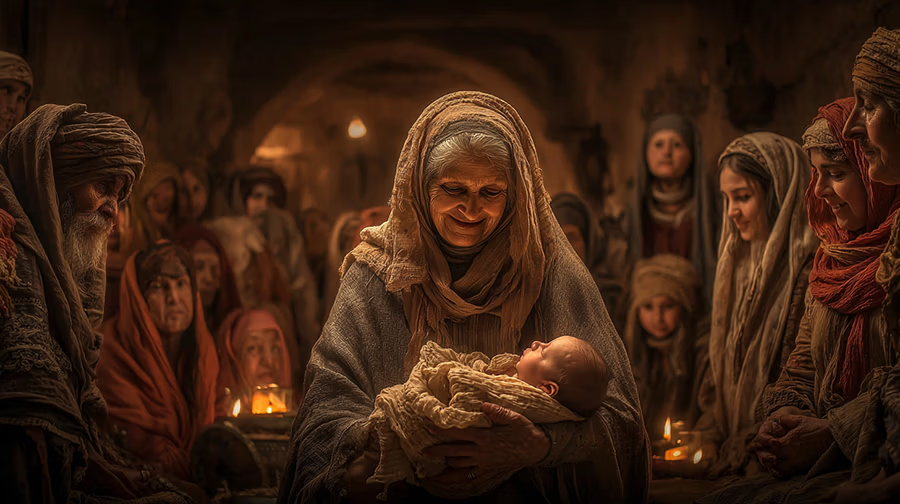
In a culture where sons represented security and legacy, calling a Moabite daughter-in-law “better than seven sons” constitutes the highest possible praise. Seven, the number of perfection in Hebrew thought, multiplied by the cultural value of sons, creates an almost incomprehensible statement of worth.
These women recognize what many modern readers miss: Ruth’s story isn’t about finding a husband or securing financial stability. It’s about covenant faithfulness (hesed) that transcends cultural boundaries and personal gain. Ruth’s commitment to Naomi, demonstrated through seasons of poverty and uncertainty, now bears fruit that will bless generations.
The Genealogy: From Obscurity to Royalty
Why does Ruth Chapter 4 end with a genealogy? The genealogy from Perez to David reveals the ultimate purpose of Ruth’s story—establishing the lineage of Israel’s greatest king and pointing forward to the Messiah. This shows how God uses faithful individuals to accomplish His redemptive plan across generations.
The Book of Ruth Chapter 4 concludes with what might seem like an anticlimactic genealogy:
“Now this is the genealogy of Perez: Perez begot Hezron; Hezron begot Ram; Ram begot Amminadab; Amminadab begot Nahshon; Nahshon begot Salmon; Salmon begot Boaz; Boaz begot Obed; Obed begot Jesse; and Jesse begot David” (Ruth 4:18-22)
This genealogy serves multiple purposes. First, it validates the entire narrative by connecting it to Israel’s most celebrated king. Second, it demonstrates God’s long-term planning—He was preparing David’s lineage generations before David’s birth. Third, it shows how God uses unexpected people (foreign widows, older bachelors) to accomplish His purposes.
The mention of David transforms Ruth’s personal story into national history. What began as one woman’s loyalty to her mother-in-law becomes a crucial link in the chain leading to Israel’s golden age under David and Solomon. This reminds us that our faithful choices, however small they seem, can have generational impact when aligned with God’s purposes, a theme we explore throughout our Books of the Bible series.
The Messianic Connection: Ruth in Christ’s Lineage
While the Book of Ruth ends with David, the New Testament reveals an even greater purpose. Matthew’s gospel includes Ruth among the four women mentioned in Christ’s genealogy (Matthew 1:5), alongside Tamar, Rahab, and Bathsheba. Each of these women entered the messianic line through unusual circumstances, demonstrating God’s grace transcending human conventions.
Ruth’s inclusion in Christ’s genealogy speaks to the universal scope of redemption. A Moabite woman—from a nation born of incest (Genesis 19:37) and excluded from Israel’s assembly (Deuteronomy 23:3)—becomes an ancestor of the Jewish Messiah who offers salvation to all nations. This paradox showcases God’s redemptive power to transform curses into blessings.
For contemporary believers facing seemingly impossible circumstances, Ruth’s story offers profound hope. God doesn’t merely work despite our limitations and difficult backgrounds—He often works through them. As we’ve explored in our study of God’s providence in Esther, the Lord delights in demonstrating His power through human weakness.
Practical Applications: Living Ruth Chapter 4 Today
How can modern Christians apply the lessons from Ruth Chapter 4? The principles of faithful waiting, legal integrity, community support, and trust in God’s providence demonstrated in this chapter provide timeless guidance for navigating contemporary challenges while maintaining biblical faithfulness.
Waiting on God’s Timing
The Book of Ruth Chapter 4 teaches patience in God’s providential timing. Ruth didn’t manipulate circumstances or compromise her integrity to secure her future. She waited, worked faithfully, and trusted God’s plan. Boaz likewise didn’t circumvent proper procedures despite his obvious interest in Ruth.
In our instant-gratification culture, this patience challenges us. Whether waiting for a spouse, career opportunity, or answered prayer, Ruth and Boaz model how to wait actively—continuing in faithfulness while trusting God’s timing. This doesn’t mean passivity; both Ruth and Boaz took appropriate action when the time came. But they refused to force God’s hand or compromise His standards.
This principle applies powerfully to our national situation. As American Christians watch concerning political and cultural developments, the temptation exists to panic or take matters into our own hands. Yet God calls us to faithful action within His timing, not fearful reaction outside His will. These are the kinds of contemporary challenges we address in our 647 – Truth Starts Now initiative.
The Power of Integrity in Public Witness
Boaz’s careful attention to legal procedure, even when he could have potentially manipulated the situation, demonstrates integrity’s power. He ensured multiple witnesses, followed established protocols, and gave the closer kinsman full opportunity to exercise his rights. This transparency created an unassailable legal foundation for his marriage to Ruth.
Modern believers need this same commitment to integrity, especially in public matters. Whether in business dealings, political engagement, or ministry activities, our methods matter as much as our goals. The ends don’t justify the means in God’s kingdom. Boaz achieved his godly desire (marrying Ruth) through godly means (following the law), setting an example for righteous living.
Community Support in God’s Work
The witnesses at the gate didn’t merely observe—they participated through their blessing and affirmation. The women of Bethlehem didn’t merely congratulate—they theologized about God’s providence and Ruth’s worth. This corporate participation in individual stories reflects God’s design for community.
Too often, modern Christianity becomes individualized, focusing solely on personal relationship with God while neglecting corporate responsibility. The Book of Ruth Chapter 4 reminds us that God’s redemptive work happens in community context. We need witnesses to our commitments, voices to speak prophetic blessing, and fellow believers to recognize and celebrate God’s providence in our lives.
This communal aspect carries special relevance for American Christians concerned about national direction. Individual faithfulness must connect with corporate action to influence culture effectively. The witnesses at Bethlehem’s gate model how communities of faith can support and validate God’s work in individuals’ lives, which is why we provide Resources to help believers connect and grow together.
The Eternal Perspective: Seeing Beyond Immediate Circumstances
What eternal truths does Ruth Chapter 4 reveal about God’s character? This chapter demonstrates God’s faithfulness across generations, His ability to redeem difficult circumstances, His inclusion of outsiders in His covenant purposes, and His sovereign orchestration of events to accomplish redemption.
God’s Faithfulness Across Generations
The genealogy ending the Book of Ruth Chapter 4 spans ten generations from Perez to David. This multi-generational view reminds us that God’s plans often exceed individual lifespans. Ruth and Boaz never met their great-grandson David, yet their faithfulness created the foundation for his kingdom.
This long-term perspective challenges our temporal focus. We often judge God’s faithfulness by immediate outcomes, forgetting He works across centuries to accomplish His purposes. The American church needs recovery of this generational thinking, making decisions based not on immediate gratification but on what will benefit our children’s children’s children. This generational perspective is central to our Mission of preserving biblical truth for future generations.
Redemption Through Unlikely Vessels
Throughout Ruth’s story, God consistently uses unlikely people to accomplish His purposes. An aging widow (Naomi), a foreign convert (Ruth), and an older bachelor (Boaz) become key players in establishing David’s lineage. This pattern continues throughout Scripture—God choosing the weak, foolish, and despised to shame the strong, wise, and honored (1 Corinthians 1:27-28).
This truth encourages believers who feel disqualified by their past, age, or circumstances. God doesn’t need perfect people—He needs willing ones. Ruth’s Moabite background didn’t disqualify her from God’s purposes; her faithful heart qualified her. Boaz’s unmarried status into middle age didn’t make him less useful to God; his integrity made him more useful.
For contemporary Christians feeling overwhelmed by cultural challenges, this offers hope. God doesn’t need a majority or cultural influence to accomplish His purposes. He needs faithful remnants willing to trust His providence even when circumstances seem impossible. God specializes in accomplishing the impossible through the improbable, as we see throughout the wisdom literature we study in Proverbs.
The Inclusive Nature of God’s Covenant
Ruth’s full acceptance into Israel’s covenant community, to the point of becoming David’s great-grandmother, demonstrates the inclusive nature of God’s redemption. The Moabites were specifically excluded from Israel’s assembly, yet God made a way for Ruth not just to enter but to become central to redemptive history.
This inclusion principle challenges both ancient and modern prejudices. The witnesses blessing Ruth as equal to Rachel and Leah, the women calling her better than seven sons—these affirmations shatter ethnic and cultural barriers. God’s covenant has always been intended for all nations, though it took Israel centuries to fully grasp this truth.
The Kinsman Redeemer: Pointing to Christ
How does Boaz as kinsman redeemer in Ruth Chapter 4 point to Jesus Christ? Boaz’s willing redemption of Ruth despite the cost prefigures Christ’s redemption of humanity. Just as Boaz paid the price to redeem Ruth from poverty and childlessness, Christ paid the ultimate price to redeem us from sin and death.
The Book of Ruth Chapter 4 provides one of Scripture’s clearest types of Christ in the person of Boaz. The Hebrew concept of the goel—the kinsman redeemer—required three qualifications: he must be a close relative, he must be able to pay the redemption price, and he must be willing to redeem. Boaz fulfilled all three for Ruth; Christ fulfills all three for humanity.
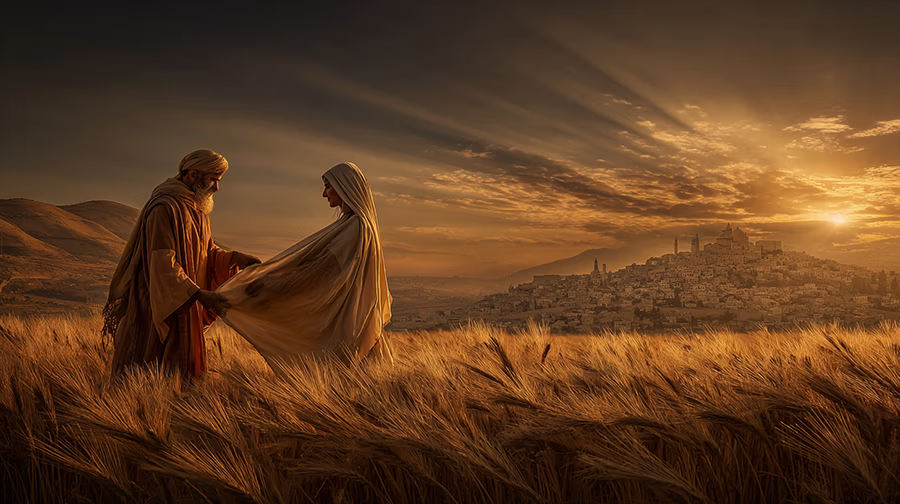
The Necessity of Relationship
The kinsman redeemer had to be related to those he redeemed. Boaz qualified through his family connection to Elimelech. Christ qualified by taking on human nature, becoming our kinsman through the incarnation. As Hebrews declares:
“He had to be made like His brethren” (Hebrews 2:17)
This enabled Him to become our faithful High Priest and Redeemer.
This relationship requirement reminds us that redemption isn’t a distant, legal transaction but a personal, relational reality. Just as Ruth came to know Boaz personally before the redemption at the gate, we must know Christ personally, not just know about Him. The legal aspects of redemption matter, but they serve the greater purpose of relationship restoration.
The Ability to Pay
The unnamed nearer kinsman wanted the land but couldn’t afford the full cost when Ruth was included. He had the relationship and perhaps the initial willingness, but he lacked the resources to complete the redemption. Boaz, however, had both the means and the willingness to pay the full price.
Christ alone had the ability to pay humanity’s redemption price. All the silver and gold in the world couldn’t redeem a single soul. Only a perfect, sinless life could satisfy divine justice. Christ possessed what no other could offer—infinite worth through His divine nature and perfect righteousness through His sinless human life.
This truth confronts every form of works-based righteousness. Just as Ruth couldn’t redeem herself despite her admirable character, we cannot redeem ourselves regardless of our moral achievements. We need a kinsman redeemer with resources beyond our own. Salvation comes not through our efforts but through Christ’s sufficient payment.
The Willingness to Redeem
Perhaps most beautifully, Boaz wanted to redeem Ruth. This wasn’t merely duty or obligation—love motivated his redemption. He had observed Ruth’s character, appreciated her loyalty to Naomi, and desired to provide for her future. His redemption flowed from affection, not mere responsibility.
Christ’s redemption likewise flows from love:
“God demonstrates His own love toward us, in that while we were still sinners, Christ died for us” (Romans 5:8)
The cross wasn’t Plan B after humanity failed; it was Plan A from before creation’s foundation. Christ willingly became our Kinsman Redeemer because of His great love, not reluctant obligation.
Contemporary Applications: Living as the Redeemed
What does Ruth Chapter 4 teach modern believers about living as redeemed people? Those redeemed by Christ should demonstrate the same loyalty, integrity, and faith shown by Ruth and Boaz, while participating in God’s ongoing redemptive work in the world.
Embracing Our New Identity
After her redemption, Ruth didn’t remain “Ruth the Moabitess” in function, though the title remained as testimony to God’s grace. She became fully integrated into Israel’s community, eventually becoming the great-grandmother of Israel’s greatest king. Her past informed but didn’t define her future.

Modern believers must similarly embrace their new identity in Christ. We acknowledge our past—it testifies to God’s transforming grace—but we don’t remain enslaved to it. Like Ruth, we become full participants in God’s covenant community with all its privileges and responsibilities. Our former status as outsiders makes our inclusion more remarkable, not less secure.
This identity shift carries special importance in our current cultural moment. As American society increasingly marginalizes biblical values, Christians might feel like outsiders in their own nation. Yet Ruth’s story reminds us that God specializes in bringing outsiders inside, in transforming strangers into family. Our citizenship in God’s kingdom supersedes any earthly marginalization, a truth we explore in The 4-3 Formula for spiritual growth.
Generational Thinking in Present Action
The Book of Ruth Chapter 4 demonstrates how present faithfulness impacts future generations. Ruth and Boaz couldn’t foresee that their son would grandfather Israel’s greatest king or that their story would encourage believers three millennia later. They simply acted faithfully in their generation, trusting God with the outcomes.
Contemporary Christians need recovery of this generational perspective. Our cultural moment demands not just resistance to present evil but investment in future good. This means making decisions based not on immediate convenience but on long-term kingdom impact. Whether in family life, church involvement, or cultural engagement, we must ask: “What legacy does this create for coming generations?”
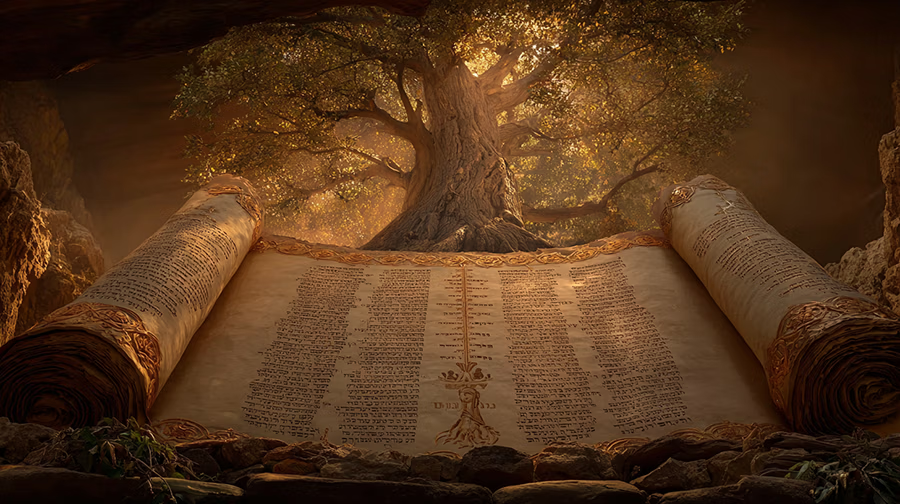
This generational thinking proves especially crucial given current challenges to religious liberty. The decisions we make today about defending religious liberty will determine what freedoms our grandchildren inherit. Like Ruth and Boaz, we must act faithfully in our generation while trusting God with the ultimate outcomes.
The Power of Ordinary Faithfulness
Nothing in Ruth Chapter 4 involves miraculous interventions or dramatic divine appearances. Instead, we see ordinary people making faithful decisions within everyday circumstances. Boaz follows legal procedures. Ruth remains loyal to Naomi. The witnesses offer customary blessings. Yet through these ordinary acts, God accomplishes extraordinary purposes.
This encourages believers who feel their lives lack spiritual significance. God doesn’t need dramatic gestures or spectacular gifts to accomplish His will. He needs ordinary faithfulness—showing up consistently, acting with integrity, loving sacrificially, and trusting steadily. The accumulation of small faithful acts often accomplishes more than occasional spectacular ones, principles we explore in Five Smooth Stones.
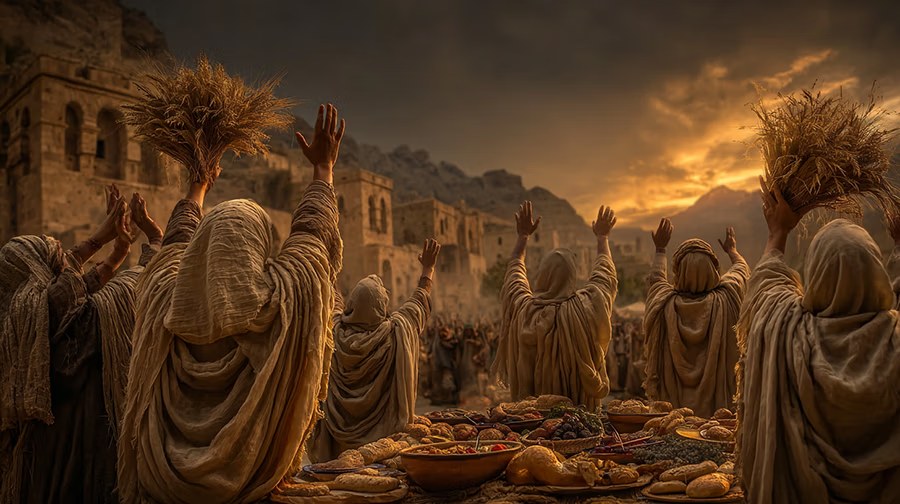
Conclusion: The Completed Redemption Story
The Book of Ruth Chapter 4 brings full circle a story that began with famine, death, and despair. What started as one woman’s tragedy in Moab concludes with celebration in Bethlehem and genealogical connection to Israel’s throne. This transformation didn’t happen through human manipulation or striving but through simple faithfulness to God’s revealed will and trust in His providence.
Ruth’s story speaks powerfully to our contemporary moment. As American Christians face increasing cultural hostility, political uncertainty, and social fragmentation, the temptation exists to despair or compromise. Yet Ruth faced far greater challenges—widowhood, poverty, foreign status, and childlessness—without the resources available to modern believers. Her response? Steadfast loyalty (hesed) to God and others, regardless of circumstances.
Boaz models masculine biblical leadership desperately needed today. He protected the vulnerable without exploiting them, followed legal procedures without manipulating them, and pursued marriage for covenant purposes rather than personal gratification. His integration of business success, spiritual maturity, and social responsibility challenges contemporary compartmentalization of life.
The witnesses at the gate remind us that God’s work requires community participation. Faith isn’t merely personal but corporate, not just individual but communal. Their prophetic blessings over Ruth and Boaz demonstrate how God uses His people to speak destiny and purpose over one another’s lives. In our individualistic age, we need recovery of this corporate dimension of faith.
Most significantly, the genealogy concluding Ruth points us to God’s ultimate purpose—redemption through the Messiah. Every story in Scripture ultimately points to Christ, and Ruth’s narrative provides one of the clearest pictures of redemption in the Old Testament. Through the kinsman redeemer Boaz, we see Christ’s greater redemption. Through Ruth’s inclusion, we see the gospel’s universal scope. Through their son Obed leading to David and eventually to Jesus, we see God’s sovereign orchestration of history toward redemption’s accomplishment.
As we face uncertain days ahead, Ruth Chapter 4 calls us to confident trust in God’s providence. The God who transformed a Moabite widow into the great-grandmother of Israel’s greatest king can surely work through our present circumstances for His glory. The God who used an older bachelor’s integrity to establish a royal lineage can surely use our faithfulness for kingdom purposes. The God who orchestrated ancient legal procedures to accomplish redemption can surely work through contemporary challenges to fulfill His purposes.
The question isn’t whether God will be faithful—He always is. The question is whether we’ll respond with Ruth’s loyalty, Boaz’s integrity, and the witnesses’ participation in God’s ongoing redemptive work. As we’ve explored throughout our journey through Ruth’s four chapters, beginning with chapter one’s trials, continuing through chapter two’s providence, and chapter three’s bold faith, God invites us to participate in His grand redemptive narrative through simple, steadfast faithfulness.
The Book of Ruth Chapter 4 doesn’t end with “happily ever after” but with “David”—pointing beyond personal happiness to kingdom purpose. Our stories likewise shouldn’t end with personal satisfaction but with kingdom contribution. What legacy will our faithfulness leave? What genealogies will trace their spiritual heritage through our obedience? What redemptive purposes will God accomplish through our ordinary faithfulness?
These questions challenge us to live with eternal perspective, embracing our role in God’s ongoing redemptive work. Like Ruth, we must choose covenant loyalty over personal convenience. Like Boaz, we must act with integrity even when shortcuts exist. Like the witnesses, we must participate in and celebrate God’s work in others’ lives. And like Naomi, we must recognize that God’s restoration often comes through unexpected means and unlikely people.
The Book of Ruth began with emptiness and ends with fullness, started with departure and concludes with arrival, opened with death and closes with birth. This trajectory from emptiness to abundance characterizes God’s redemptive work throughout history. Whatever emptiness we face—spiritual, relational, financial, or societal—God specializes in transformation through redemption.
As we apply these truths to contemporary challenges, remembering that our constitutional republic depends on biblical faithfulness, we find hope not in political solutions but in God’s providential sovereignty. The same God who worked through Ruth’s faithfulness in ancient Bethlehem works through our faithfulness in modern America. The question remains: Will we trust Him enough to act with integrity, wait with patience, and serve with loyalty, even when the outcome remains uncertain?
The Book of Ruth Chapter 4 answers with resounding affirmation: God remains faithful across generations, accomplishing His purposes through ordinary people who simply trust and obey. In these challenging times, may we demonstrate the same steadfast faith, confident that the God of Ruth and Boaz remains our God today, working all things together for good for those who love Him and are called according to His purpose.
Frequently Asked Questions (FAQs)
What is the main spiritual lesson from Ruth Chapter 4?
The primary lesson from Ruth Chapter 4 is that God sovereignly orchestrates circumstances to accomplish His redemptive purposes through ordinary people’s faithful obedience. When we trust God’s providence and act with integrity like Boaz and Ruth, He can transform our most difficult circumstances into blessings that impact generations, ultimately pointing to Christ our perfect Kinsman Redeemer.
Why is the genealogy at the end of Ruth 4 important?
The genealogy transforms Ruth’s personal story into Israel’s national history by revealing she became King David’s great-grandmother. This connection shows God’s long-term planning and demonstrates how He uses unexpected people—including a foreign widow—to accomplish His purposes, ultimately leading to Jesus Christ’s lineage as revealed in Matthew’s Gospel.
How does Boaz represent Christ as our Kinsman Redeemer?
Boaz perfectly illustrates Christ’s redemptive work by meeting all three requirements of a kinsman redeemer: being a close relative (Christ became human), having ability to pay the redemption price (Christ’s sinless life), and being willing to redeem (Christ’s love-motivated sacrifice). Just as Boaz legally redeemed Ruth from poverty and childlessness, Christ spiritually redeems us from sin and death.
What can modern Christians learn from the legal proceedings at the gate?
The transparent legal process at Bethlehem’s gate teaches the importance of integrity, proper witnesses, and following established procedures even when we could take shortcuts. This models how Christians should conduct business and make decisions—with transparency, accountability, and respect for law and order, trusting that God honors integrity over manipulation.
External Links for Further Reading
- Understanding the Kinsman Redeemer in Ancient Israel – Archaeological insights into ancient Hebrew redemption laws
- The Genealogy of Jesus Through David’s Line – Scholarly analysis of messianic lineage
- Ancient Near Eastern Legal Customs – Academic research on biblical-era legal procedures
- The Role of City Gates in Ancient Israel – Historical context for understanding biblical gate proceedings
- Hebrew Concepts of Hesed and Redemption – Theological exploration of covenant loyalty in Ruth

